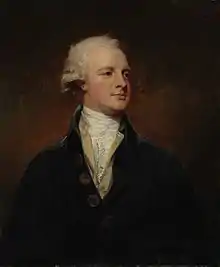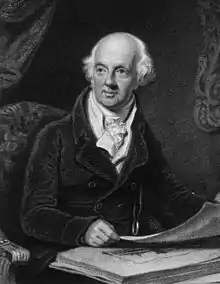Sir Abraham Hume, 2nd Baronet
Sir Abraham Hume, 2nd Baronet (29 February 1749 – 24 March 1838, in London) was a British floriculturist and Tory politician who sat in the House of Commons between 1774 and 1818.

He was born the eldest son of Sir Abraham Hume, 1st Baronet, of Wormleybury, Hertfordshire, whom he succeeded in 1772, inheriting his title and the Wormleybury estate.

He was appointed High Sheriff of Hertfordshire for 1774 [1] and also elected at the 1774 general election as a Member of Parliament (MP) for the borough of Petersfield in Hampshire,[2] and holding the seat until the 1780 general election, when he did not contest Petersfield again.[3]
He was returned to the House of Commons 27 years later, at the 1807 general election as an MP for the borough of Hastings in Sussex.[4] He resigned the seat in early 1812 in order to contest a by-election in Boston,[4] where he was defeated in April 1812,[5] and was then re-elected for Hastings at a by-election later the same month.[4] At the 1812 general election, he contested both Boston[5] and Hastings,[4] but was elected only in the latter, and held that seat until the 1818 general election,[6] when he contested neither Boston[4] nor Hastings.[4]

Both Sir Abraham Hume and his wife Amelia Egerton were active as rosarians and developed several rose cultivars at their estate in Hertfordshire. He was elected a Fellow of the Royal Society in December 1775,[7] and one of the founding members of the Geological Society and the British Institution.
He was a keen art collector, especially of Old Master prints and drawings (drawings by Polidoro da Caravaggio were a particular favourite). He was friends with Sir Joshua Reynolds who left him in his will a small painting by Claude Lorraine, now in the Metropolitan Museum of Art, New York.
He died in 1838. He had married Amelia Egerton (25 November 1751 – 8 August 1809), daughter of John Egerton, Bishop of Durham.[8] They had two daughters, both of whom predeceased him:
- Amelia Hume (21 January 1772 – 15 January 1837), who married Charles Long, 1st Baron Farnborough
- Amelia Sophia Hume (31 July 1788 – 21 February 1814), who married John Cust, 1st Earl Brownlow.
The Baronetcy thereby became extinct and the Wormleybury estate passed to the male children of Lady Brownlow (Viscount Alford and the Hon. Charles Henry Cust) who jointly sold it in 1853 to a Henry John Grant.
References
- Complete Baronetage
- Stooks Smith, Henry. (1973) [1844–1850]. Craig, F. W. S. (ed.). The Parliaments of England (2nd ed.). Chichester: Parliamentary Research Services. p. 130. ISBN 0-900178-13-2.
- "HUME, Sir Abraham, 2nd Bt. (1749-1838), of Wormleybury, Herts". History of Parliament Online. Retrieved 3 December 2017.
- Stooks Smith, pages 337–8
- Stooks Smith, page 197
- Leigh Rayment's Historical List of MPs – Constituencies beginning with "H" (part 2)
- "Library and Archive Catalog". Royal Society. Retrieved 27 November 2010.
- See Hume, Abraham (1749–1838), in Dictionary of National Biography, 1885–1900, Volume 28.
Bibliography
- Sir Abraham Hume
- Drummond, Henry (1844). History of Noble British Families. London: William Pickering.
External links
- Hansard 1803–2005: contributions in Parliament by Sir Abraham Hume
| Parliament of Great Britain | ||
|---|---|---|
| Preceded by Welbore Ellis William Jolliffe |
Member of Parliament for Petersfield 1774–1780 With: William Jolliffe |
Succeeded by Thomas Jolliffe William Jolliffe |
| Parliament of the United Kingdom | ||
| Preceded by Sir William Middleton, Bt Sir John Nicholl |
Member of Parliament for Hastings 1807–1818 With: George Canning 1807–12 James Dawkins 1812–18 |
Succeeded by George Peter Holford James Dawkins |
| Baronetage of Great Britain | ||
| Preceded by Abraham Hume |
Baronet (of Wormleybury, Herts) 1772–1838 |
Extinct |